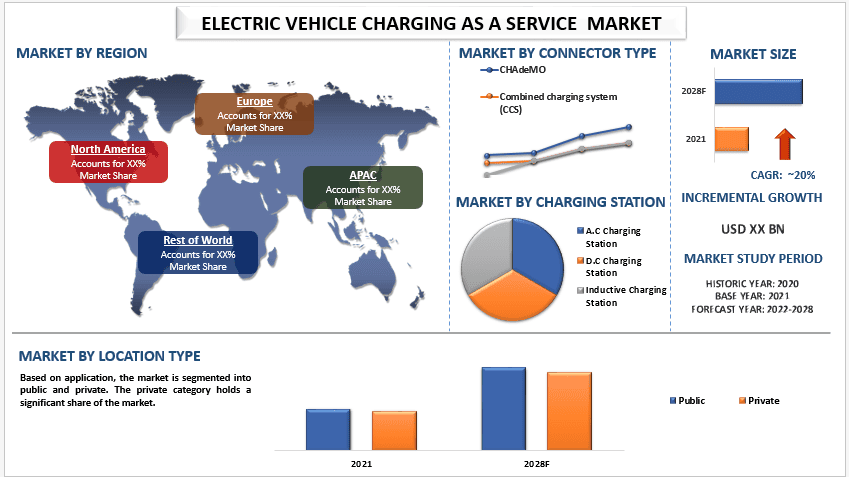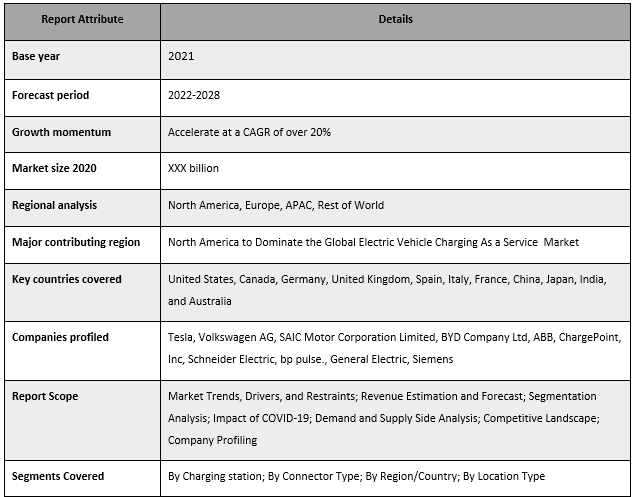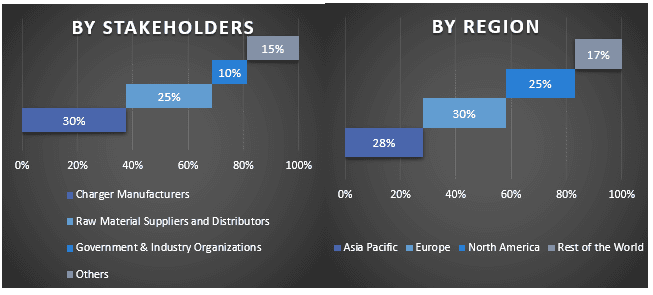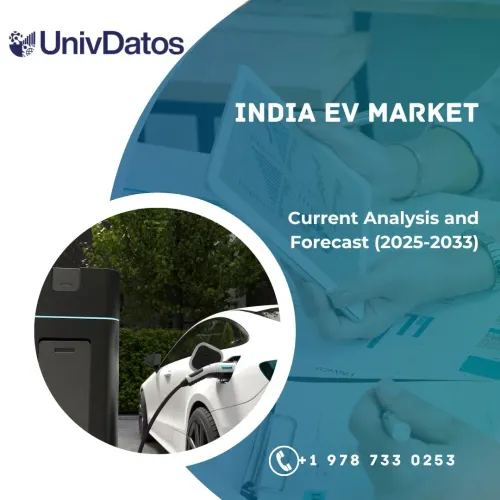- Home
- About Us
- Industry
- Services
- Reading
- Contact Us
Electric Vehicle Charging as a Service Market: Current Analysis and Forecast (2022-2028)
Emphasis on Charging Station (A.C Charging Station, D.C Charging Station, and Inductive Charging Station); Connector Type (CHAdeMO, CCD, and Others); Location Type (Public and Private); and Region/Country

Global Electric Vehicle Charging as a Service Market is expected to grow at a significant rate of around 20% during the forecast period. Electric Vehicle (EV) charging as a service is a business model in which third-party companies offer EV charging infrastructure to EV owners, either through a subscription-based model or a pay-per-use charging model. The service includes the installation, operation, and maintenance of the charging infrastructure. This model is becoming increasingly popular due to the growing adoption of EVs and the need for a reliable charging infrastructure. Many governments around the world are offering incentives and enacting regulations to encourage the adoption of electric vehicles (EVs) and the development of charging infrastructure. For example, in the UK, the government has set a target for all new cars and vans to be zero-emission by 2030 and is providing grants to help fund the installation of EV charging infrastructure. Moreover, the increasing popularity of EVs is a major driver of the electric vehicle charging as a service market. As more people buy electric cars, the demand for charging infrastructure grows. For instance, in Norway, where EV adoption is high, there are more electric vehicle charging stations per capita than anywhere else in the world.
Tesla, Volkswagen AG, SAIC Motor Corporation Limited, BYD Company Ltd, ABB, ChargePoint, Inc, Schneider Electric, bp pulse., General Electric, Siemens. are some of the key players in the market. Several M&As along with partnerships have been undertaken by these players to facilitate customers with hi-tech and innovative products/technologies.
Insights Presented in the Report
“Amongst connector type, combined charging system (CCS) vehicles category to witness significant growth during the forecast period.”
Based on type, the market is segmented into CHAdeMO, CCD, and others. The combined charging system (CCS) segment of electric vehicle (EV) charging as a service is experiencing significant growth due to several drivers. The first driver is the increase in the adoption of EVs globally. The number of EVs on the road has been steadily increasing, and as a result, there is a growing need for charging infrastructure. CCS is seen as an important standard for fast charging, enabling the charging of an EV in as little as 30 minutes. The second driver is the increasing demand for fast charging. With the growth of EVs, consumers are looking for fast and convenient charging solutions. CCS is seen as a standard for fast charging, and it has the potential to charge an EV in as little as 30 minutes. This is important for consumers who want to be able to charge their vehicles quickly and efficiently.
“Amongst location type, the public category to witness significant growth in upcoming forecast period.”
On the basis of location type, the market is categorized into public and private. The public segment of electric vehicle (EV) charging as a service has witnessed significant growth in recent years, and there are several drivers behind this trend. One of the primary drivers is the increasing adoption of EVs globally. As more consumers switch to EVs, the demand for public charging infrastructure grows. This has created a significant opportunity for companies that provide EV charging services to expand their networks and increase their market share. Another key driver behind the growth of public EV charging services is government support. Many countries and regions have implemented policies and incentives to encourage the adoption of EVs, including subsidies for EV purchases and the development of public charging infrastructure. For example, the European Union has set a goal of installing 1 million public charging stations by 2025, which has created a significant market opportunity for charging service providers.
“North America expected to witness significant growth in the market.”
North America is expected to witness significant growth in Electric Vehicle (EV) charging as a service market in the upcoming forecast period due to several factors. Firstly, there has been a significant increase in EV adoption in North America, driven by various factors such as environmental concerns, government incentives, and improvements in technology. This increase in EV adoption has created a demand for reliable and convenient charging infrastructure. Secondly, there is a growing focus on sustainability and reducing greenhouse gas emissions in North America, which has led to increased investment in EV charging infrastructure. Government initiatives, such as tax incentives and grants, have encouraged the development of charging infrastructure, especially in urban areas. Thirdly, North America has a well-developed technology and innovative ecosystem that supports the development of new EV charging technologies and business models. This has led to the emergence of innovative companies that are focused on providing EV charging as a service and are helping to drive the growth of the industry. Finally, North America has a well-established regulatory framework that supports the development of EV charging infrastructure. This framework provides clarity and stability for businesses operating in the industry and encourages investment in charging infrastructure.
Electric Vehicle Charging As a Service Market Report Coverage

Reasons to buy this report:
- The study includes market sizing and forecasting analysis validated by authenticated key industry experts.
- The report presents a quick review of overall industry performance at one glance.
- The report covers an in-depth analysis of prominent industry peers with a primary focus on key business financials, product portfolio, expansion strategies, and recent developments.
- Detailed examination of drivers, restraints, key trends, and opportunities prevailing in the industry.
- The study comprehensively covers the market across different segments.
- Deep dive regional level analysis of the industry.
Customization Options:
The global electric vehicle charging as a service market can further be customized as per the requirement or any other market segment. Besides this, UMI understands that you may have your own business needs, hence feel free to connect with us to get a report that completely suits your requirements.
Table of Content
Research Methodology for the Electric Vehicle Charging as a Service Market Analysis (2022-2028)
Analyzing the historical market, estimating the current market, and forecasting the future market of the global electric vehicle charging as a service market were the three major steps undertaken to create and analyze the adoption of electric vehicle charging as a service in major regions globally. Exhaustive secondary research was conducted to collect the historical market numbers and estimate the current market size. Secondly, to validate these insights, numerous findings and assumptions were taken into consideration. Moreover, exhaustive primary interviews were also conducted, with industry experts across the value chain of the global electric vehicle charging as a service market. Post assumption and validation of market numbers through primary interviews, we employed a top-down/bottom-up approach to forecasting the complete market size. Thereafter, market breakdown and data triangulation methods were adopted to estimate and analyze the market size of segments and sub-segments of the industry pertains to. Detailed methodology is explained below:
Analysis of Historical Market Size
Step 1: In-Depth Study of Secondary Sources:
Detail secondary study was conducted to obtain the historical market size of the electric vehicle charging as a service market through company internal sources such as annual reports & financial statements, performance presentations, press releases, etc., and external sources including journals, news & articles, government publications, competitor publications, sector reports, third-party database, and other credible publications.
Step 2: Market Segmentation:
After obtaining the historical market size of the electric vehicle charging as a service market, we conducted a detailed secondary analysis to gather historical market insights and share for different segments & sub-segments for major regions. Major segments are included in the report as charging type, connector type, and location type. Further country-level analyses were conducted to evaluate the overall adoption of testing models in that region.
Step 3: Factor Analysis:
After acquiring the historical market size of different segments and sub-segments, we conducted a detailed factor analysis to estimate the current market size of electric vehicle charging as a service market. Further, we conducted factor analysis using dependent and independent variables such as various charging type, connector type, and location type electric vehicle charging as a service. A thorough analysis was conducted for demand and supply-side scenarios considering top partnerships, mergers and acquisitions, business expansion, and product launches in the electric vehicle charging as a service market sector across the globe.
Current Market Size Estimate & Forecast
Current Market Sizing: Based on actionable insights from the above 3 steps, we arrived at the current market size, key players in the global electric vehicle charging as a service market, and market shares of the segments. All the required percentage shares split, and market breakdowns were determined using the above-mentioned secondary approach and were verified through primary interviews.
Estimation & Forecasting: For market estimation and forecast, weights were assigned to different factors including drivers & trends, restraints, and opportunities available for the stakeholders. After analyzing these factors, relevant forecasting techniques i.e., the top-down/bottom-up approach were applied to arrive at the market forecast for 2028 for different segments and sub-segments across the major markets globally. The research methodology adopted to estimate the market size encompasses:
- The industry’s market size, in terms of revenue (USD) and the adoption rate of the electric vehicle charging as a service market across the major markets domestically
- All percentage shares, splits, and breakdowns of market segments and sub-segments
- Key players in the global electric vehicle charging as a service market in terms of products offered. Also, the growth strategies adopted by these players to compete in the fast-growing market
Market Size and Share Validation
Primary Research: In-depth interviews were conducted with the Key Opinion Leaders (KOLs) including Top Level Executives (CXO/VPs, Sales Head, Marketing Head, Operational Head, Regional Head, Country Head, etc.) across major regions. Primary research findings were then summarized, and statistical analysis was performed to prove the stated hypothesis. Inputs from primary research were consolidated with secondary findings, hence turning information into actionable insights.
Split of Primary Participants in Different Regions

Market Engineering
The data triangulation technique was employed to complete the overall market estimation and to arrive at precise statistical numbers for each segment and sub-segment of the global electric vehicle charging as a service market. Data was split into several segments & sub-segments post studying various parameters and trends in the areas of charging type, connector type, and location type in the global electric vehicle charging as a service market.
The main objective of the Global Electric Vehicle Charging as a Service Market Study
The current & future market trends of the global electric vehicle charging as a service market were pinpointed in the study. Investors can gain strategic insights to base their discretion for investments on the qualitative and quantitative analysis performed in the study. Current and future market trends determined the overall attractiveness of the market at a regional level, providing a platform for the industrial participant to exploit the untapped market to benefit from a first-mover advantage. Other quantitative goals of the studies include:
- Analyze the current and forecast market size of the electric vehicle charging as a service market in terms of value (USD). Also, analyze the current and forecast market size of different segments and sub-segments
- Segments in the study include areas of charging type, connector type, and location type.
- Define and analysis of the regulatory framework for the electric vehicle charging as a service
- Analyze the value chain involved with the presence of various intermediaries, along with analyzing customer and competitor behaviors of the industry.
- Analyze the current and forecast market size of the electric vehicle charging as a service market for the major region.
- Major countries of regions studied in the report include Asia Pacific, Europe, North America, and the Rest of the World.
- Company profiles of the electric vehicle charging as a service market and the growth strategies adopted by the market players to sustain in the fast-growing market
- Deep dive regional level analysis of the industry
Related Reports
Customers who bought this item also bought










